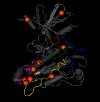Variable Somatic TIE2 Mutations in Half of Sporadic Venous Malformations
- PMID: 23801934
- PMCID: PMC3666452
- DOI: 10.1159/000348327
Variable Somatic TIE2 Mutations in Half of Sporadic Venous Malformations
Abstract
Venous malformations (VMs) are the most frequent vascular malformations referred to specialized vascular anomaly centers. A rare (1-2%) familial form, termed cutaneomucosal venous malformation (VMCM), is caused by gain-of-function mutations in TIE2. More recently, sporadic VMs, characterized by the presence of large unifocal lesions, were shown to be caused by somatic mutations in TIE2. These include a frequent L914F change, and a series of double mutations in cis. All of which cause ligand-independent receptor hyperphosphorylation in vitro. Here, we expanded our study to assess the range of mutations that cause sporadic VM. To test for somatic changes, we screened the entire coding region of TIE2 in cDNA from resected VMs by direct sequencing. We detected TIE2 mutations in 17/30 (56.7%) of the samples. In addition to previously detected mutations, we identified 7 novel somatic intracellular TIE2 mutations in sporadic VMs, including 3 that cause premature protein truncation.
Keywords: Hyperphosphorylation; Receptor tyrosine kinase; Somatic mutation; Sporadic; TIE2/TEK; Vascular malformation; Venous malformation.
Figures



References
-
- Boon LM, Vikkula M. Vascular anomalies. In: Wolff K, Goldsmith LA, Katz SI, Gilchrest BA, Paller AS, et al., editors. Fitzpatrick's Dermatology in General Medicine. 8. New York: McGraw-Hill Professional Publishing; 2012.
-
- Boon LM, Mulliken JB, Enjolras O, Vikkula M. Glomuvenous malformation (glomangioma) and venous malformation: distinct clinicopathologic and genetic entities. Arch Dermatol. 2004;140:971–976. - PubMed
-
- Brouillard P, Vikkula M. Genetic causes of vascular malformations. Hum Mol Genet. 2007;16(Spec No. 2):R140–149. - PubMed
-
- Calvert JT, Riney TJ, Kontos CD, Cha EH, Prieto VG, et al. Allelic and locus heterogeneity in inherited venous malformations. Hum Mol Genet. 1999;8:1279–1289. - PubMed
Grants and funding
LinkOut - more resources
Full Text Sources
Other Literature Sources
Miscellaneous

